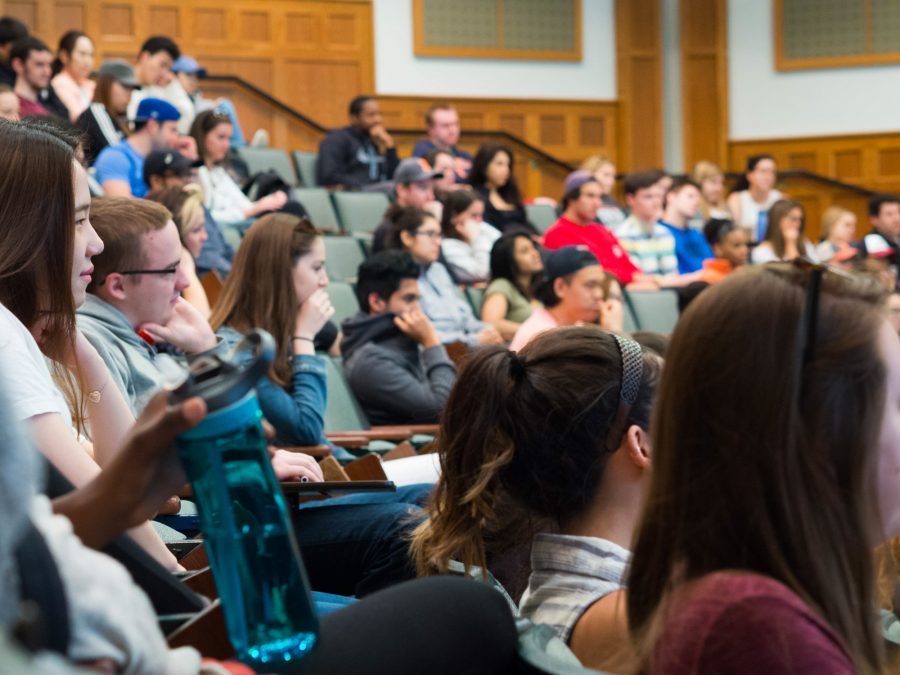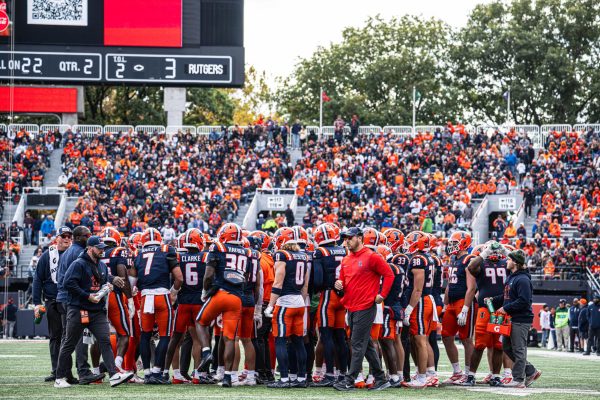How to make big lectures more impactful
Students are engaged in Professor Lena Hann’s last lecture at UIUC. Tuesday, May 3.
Jul 20, 2016
Many aspects of college take some time to get used to. For many, it’s the first time away from home with a roommate. New students, especially freshmen, have to learn to budget their time now that their schedule is left entirely up to them.
One of the biggest adjustments that most students need to make is dealing with the size of some of their classes.
Most are not used to having more than 30 to 40 people in one class, but that will change when you walk into ECON 102 or STAT 100. Some general education classes consist of anywhere from 300 to 700 students.
Daunting as it may seem, this will eventually become commonplace. By the time midterms roll around, strolling into your 9 a.m. ECON lecture won’t phase you a bit (that is if you can wake up in time). Here are a few tips that will help you get off to the right start in your large lectures.
Sit wherever works best for you
Get The Daily Illini in your inbox!
Coming into my freshman year, I had multiple professors and students tell me that to get the most out of huge lectures, I had to sit in the front. They said that if I sat in the front, I’d be able to focus on what the professor was saying without being distracted by a sea of students talking and surfing the internet in front of me.
This lasted about a week.
I quickly found out that sitting in the very front of a giant lecture hall isn’t the best way for me to learn. Seeing as most lectures consist of the professor going over slides on a large screen in the front of the room, my neck was sore by the third day of class from looking straight up all the time. It was also hard to see the information as a whole on the screen.
I eventually moved around until I found a spot where I could focus without wandering off. Personally, I like sitting in the back half of the room, but not all the way back.
You may find that sitting in the front works for you, or that sitting in the very back makes you feel more comfortable and ready to take notes. No one is going to judge you for where you sit, so make sure to find a spot where you’ll pay attention.
Make friends with those who consistently sit near you.
One thing that you’ll notice as the first few weeks of classes progress is that most students will sit in the same seat each time.
There will be the occasional period where someone sits in your seat–these people are the worst. You know it’s your seat. The people who sit near you every class period know it’s your seat.
Then you’re forced to move and possibly take someone else’s seat, creating a vicious cycle that throws off the entire balance of the lecture hall.
However, once you’ve established your seat, it’s important to get to know the people who sit near you every class period. They will become your lifeline in case you miss a lecture or need someone to study with for the midterm. In such large lectures, it’s critical to have a small group of students in the class with whom you can go over the material.
And who knows, you might just meet your best friend for the next four years in the back of STAT 100.
Summarize Notes
Knowing how to summarize notes is easily the most valuable skill I learned freshman year. Coming into college, I knew how to take notes, but not effectively. I got by the first few weeks of school by simply typing down what the professor put up on slides verbatim.
When midterms rolled around, I realized I hadn’t been retaining any of the information that I had so diligently written down every class. That’s when a friend told me to start summarizing my notes.
For me, I found that summing up information on the spot was too much, especially when professors seem to think that the class can retain an entire slide’s worth of information in three and a half seconds. Instead, I wrote down the information verbatim during class, and then I would go back after class and jot down a one to two sentence summary of each slide at the bottom.
This not only got me thinking about the material on a deeper level, but by reading through my notes following the lecture, I retained more of the information and even did some proactive studying. It doesn’t take more than 10 minutes to do, and you will clearly see the benefits when test time comes.
Jason is a senior in Media.
[email protected]






